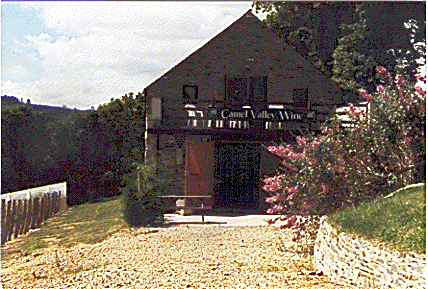
Left-Camel Valley's winery and tourist centre
Many of the smaller vineyards of England make their own wine, often with the aid of tiny basket presses and polythene storage tanks. This is especially true in Cornwall, where the vineyards are so scattered that centralised wine making is difficult. Quality control is maintained by regular 'testing' meetings where the wine makers bring a bottle and compare notes.

Left-Camel Valley's winery and tourist centre
In East Anglia, contract wine-making is available from Shawsgate and New Hall
vineyards.

The usual vineyard clutter as the harvest comes in
The wineries themselves represent a serious investment for the owners. Peter Hall at Breaky Bottom in Sussex built a winery simply because he thought that contract winemakers were ruining his grapes (The subsequent gold medals have proved him right !)
Chemists seemed to form a significant group of early winemakers. In Kent, former Imperial college
lecturer John Gibson had considerable success at Bearsted and the Danilewicz brothers
made Quality wines at Barnsole near Deal . In Avon,
Mumfords was also run by Dr. John Cox
Many pioneers have now been replaced by graduates of Plumpton, Britain's only wine University.
What does set apart the English wines from much of the foreign
competition is the wide variety of grapes that can be grown. There are
no French style restrictions on what can be grown and grapes such as
Schonburger, Reichensteiner and Huxelrebe are encouraged.
The result is some wines with strong grape flavours that unlike the popular Chardonnay,
do not need a large amount of oak to give them some taste. To me, it
is the sign of a good wine maker when the natural flavours come
through.
In recent years, there has been increased planting of the quality grapes, such as Pinot Noir )several clones suitable for early ripening), Chardonnay and Pinot Gris. Reisling has never been a successful planting, as it invariably fails to ripen.